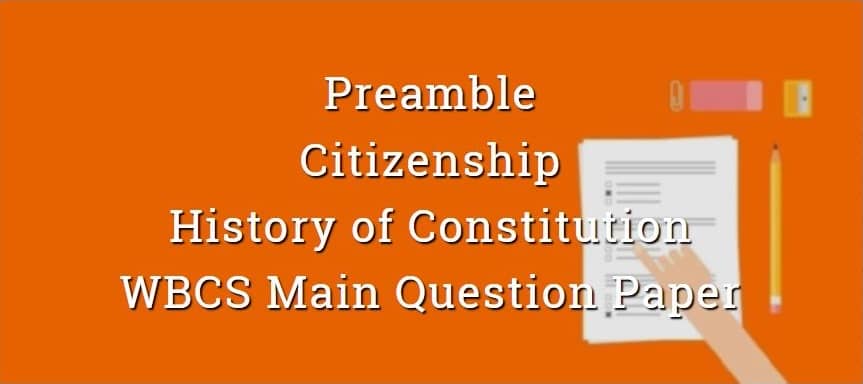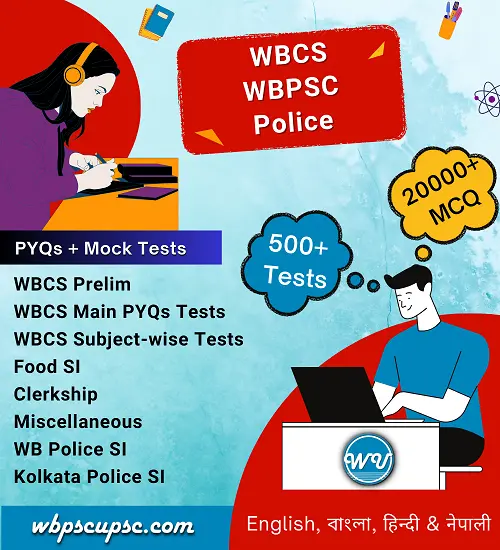Contents

wbcs main polity question and answer
WBCS Main Question Paper – 2023
6. Choose the correct statement stated in the Constitution of India:
(A) India, that is Bharat, shall be a Federation of States
(B) India, that is Bharat, shall be a Union of States
(C) India, that is Bharat, shall be a Quasi Federal State
(D) India, that is Bharat, shall be a Unitary State
8. National Capital Territory of Delhi was constituted by
(A) Ordinance promulgated by the Lieutenant Governor
(B) Ordinance promulgated by the President
(C) 71st Amendment
(D) 69th Amendment
18. The Sixth Schedule of the Constitution of India does not provide Administration for
(A) Assam
(B) Meghalaya
(C) Tripura
(D) Manipur
21. Which of the following amendments to the Constitution of India is also referred to as the ‘mini Constitution‘?
(A) 38th Amendment
(B) 42nd Amendment
(C) 35th Amendment
(D) 40th Amendment
24. Which part of the Constitution of India describes citizenship at the commencement of the Constitution?
(A) Part I
(B) Part II
(C) Part III
(D) Part IV
26. Sanskrit is the 2nd official language of which State in India?
(A) Karnataka
(B) Madhya Pradesh
(C) Uttarakhand
(D) Himachal Pradesh
28. The original Constitution of India was handwritten by
(A) Rafi Ahmed Kidwai
(B) Prem Behari Narain Raizada
(C) Kailash Nath Katju
(D) Kanaiyalal Maneklal Munshi
29. The National Flag of Indian Union was adopted on _______.
(A) 15th August, 1947
(B) 26th November, 1949
(C) 22nd July, 1947
(D) 26th January, 1950
31. The Constitution declares India to be a sovereign, socialist, democratic republic, assuring citizens of justice, equality and liberty, and endeavours to promote fraternity among them. The words “socialist” and “secular” were added to the definition in year:
(A) 1956
(B) 1976
(C) 1970
(D) 1952
32. 53rd Amendment of the Indian Constitution 1986 made full Statehood for
(A) Mizoram
(B) Tripura
(C) Manipur
(D) Meghalaya
35. The 10th Schedule of the Indian Constitution talks about
(A) Municipalities
(B) Forms of Oaths
(C) Validation of Regulations
(D) Anti Defection Act
36. Which Schedule of the Constitution of India prescribes the Forms of Oaths or Affirmations?
(A) 11th Schedule
(B) 4th Schedule
(C) 3rd Schedule
(D) 5th Schedule
39. How many Articles were written on the Constitution when it came into effect?
(A) 410 Articles
(B) 415 Articles
(C) 365 Articles
(D) 395 Articles
40. What does the 8th Schedule of the Indian Constitution deals with?
(A) Administration of Tribal Areas
(B) Panchayat Raj
(C) Official Languages
(D) Municipalities
41. The Preamble of the Indian Constitution was inspired by the Preamble of the Constitution of which country?
(A) U.S. Constitution
(B) Swiss Constitution
(C) British Constitution
(D) Constitution of Canada
42. At which of its session, did the Congress officially accept the ‘Socialistic pattern of Society‘?
(A) Bombay Session of 1953
(B) Avadi Session of 1955
(C) Calcutta Session of 1957
(D) Nagpur Session of 1959
45. Who among the following gave the following statement about the Indian Constitution?
‘Indian Constitution strikes a good balance between extreme rigidity and too much flexibility.’
(A) B. R. Ambedkar
(B) M.V. Pylee
(C) Alexandrowicz
(D) K.C. Wheare
46. From which country was the idea of ‘Concurrent List‘ in the Indian Constitution borrowed?
(A) Japan
(B) United States
(C) Australia
(D) China
56. How many schedules are there in the Indian Constitution?
(A) 22
(B) 17
(C) 97
(D) 12
59. In which year did Goa became the 25th State of India?
(A) 1987
(B) 1988
(C) 1989
(D) 1990
61. Which schedule contains ‘Forms of Oath and Affirmations‘ ?
(A) Eleventh Schedule
(B) Fourth Schedule
(C) Third Schedule
(D) Fifth Schedule
71. The States were reorganized in the year 1956 mainly on the basis of which criteria?
(A) External and internal security
(B) Administration facility
(C) Linguistic and cultural uniformity
(D) Geographic similarity and resource allocation
79. Which Amendment Act made Sikkim a full-fledged State of India?
(A) 34th Constitutional Amendment Act
(B) 35th Constitutional Amendment Act
(C) 36th Constitutional Amendment Act
(D) 37th Constitutional Amendment Act
82. Which Act granted Statehood to Arunachal Pradesh?
(A) Constitution Act, 1981
(B) Constitution Act, 1987
(C) Government of India Act, 1981
(D) Government of India Act, 1987
86. From which country was the idea of concurrent list borrowed in India?
(A) Japan
(B) United States of America
(C) Australia
(D) China
92. Which among the following languages was included in the eighth schedule by Constitution (21st) amendment Bill on 10 April 1967?
(A) Assamese
(B) Sindhi
(C) Gujarati
(D) Konkani
97. Who was elected as the Permanent President of the Constituent Assembly?
(A) Dr. Rajendra Prasad
(B) B. R. Ambedkar
(C) Sardar Vallabhbhai Patel
(D) Frank Anthony
98. Which Right was not taken from the British Constitution in the Indian Constitution?
(A) Freedom of Press
(B) Right to Vote
(C) Fundamental Rights
(D) Educational Rights
99. The original Constitution of India had how many Articles and Schedules?
(A) 392 Articles and 7 Schedules
(B) 395 Articles and 8 Schedules
(C) 395 Articles and 6 Schedules
(D) 396 Articles and 4 Schedules
100. In India the concept of single citizenship is adopted from
(A) The French Constitution
(B) The Swiss Constitution
(C) The Constitution of United States of America
(D) The British Constitution
WBCS Main Question Paper – 2022
4. Which is the correct sequence in the Preamble of the Constitution of India?
(A) Sovereign, Secular, Socialist, Democratic, Republic
(B) Sovereign, Socialist, Secular, Republic, Democratic
(C) Sovereign, Secular, Socialist, Republic, Democratic
(D) Sovereign, Socialist, Secular, Democratic, Republic
14. “Economic Justice” as one of the objectives of the constitution of India has been provided in
(A) Preamble and Fundamental Rights
(B) Preamble and Directive Principles
(C) Fundamental Rights and Directive Principles
(D) Preamble, Fundamental Rights and Directive Principles
16. How many scheduled languages are there in the Eighth Schedule of the Constitution of India?
(A) 12
(B) 17
(C) 22
(D) 24
23. How many members were there in the Constituent Assembly?
(A) 389
(B) 192
(C) 289
(D) 292
39. Who was the advisor of the Constituent Assembly?
(A) B. R. Ambedkar
(B) B. N. Rao
(C) Alldai Krishnaswamy
(D) T. T. Krishnamachari
46. The Objective Resolution in the Constituent Assembly was moved by
(A) Pandit Jawaharlal Nehru
(B) Dr. B. R. Ambedkar
(C) Dr. Rajendra Prasad
(D) Lord Mountbatten
50. The ideals of “liberty, equality and fraternity” in the Preamble of the Constitution of India is inspired by
(A) Russian revolution
(B) French revolution
(C) Marxian thoughts
(D) Gandhian thoughts
52. The Fundamental Duties in the Constitution of India were adopted from
(A) American Constitution
(B) Russian Constitution
(C) Canadian Constitution
(D) French Constitution
54. The Constitution of India adopted the federal system from the Act of
(A) 1919
(B) 1935
(C) 1947
(D) 1909
57. The word “secularism” was added to the Preamble of the Constitution of India by which
amendment?
(1976)
(A) 40th
(B) 42nd
(C) 44th
(D) 46th
60. The Concurrent list in the Constitution of India was adopted from
(A) Australia
(B) Canada
(C) Russia
(D) UK
63. The Constituent Assembly was set according to the proposals of
(A) The Cripps Mission
(B) The Cabinet Mission
(C) The Mountbatten Plan
(D) None of the Above
72. The Constitution of India describes India as a
(Article 1)
(A) Federation of Independent States
(B) Union of States
(C) Quasi federation
(D) Dominion of States
74. The word “procedure established by law” in the Constitution of India have been borrowed from
(A) The Constitution of UK
(B) The Constitution of USA
(C) The French Constitution
(D) The Constitution of Japan
85. Who was the Chairman of the Constitution Drafting Committee?
(A) Jawaharlal Nehru
(B) Dr. B. R. Ambedkar
(C) Dr. Rajendra Prasad
(D) Sardar Vallabhai Patel
87. Which of the following is not a feature of the Constitution of India?
(A) It is democratic
(B) It is republic
(C) It is federal
(D) It is presidential
99. The word “socialist” was added to the Preamble of the Constitution of India by which amendment?
(A) 44th
(B) 27th
(C) 21st
(D) 42nd
WBCS Main Question Paper – 2021
8. Which is the ‘Soul’ of the Indian Constitution?
(A) Fundamental Rights
(B) Preamble
(C) both (i) and (ii)
(D) None of the above
23. Where are the words ‘Unity and Integrity of the Nation’ are found?
(A) Directive Principles of State Policy.
(B) Emergency Provisions
(C) Fundamental Duties
(D) Preamble
24. When was the First Amendment Bill passed?
(June)
(A) 1950
(B) 1952
(C) 1951
(D) 1954
28. When was the Constitution of India enacted by the Constituent Assembly?
(A) 26 January, 1950
(B) 26 November, 1949
(C) 26 January, 1949
(D) 20 January, 1949
37. Where was the first Session of the Constituent Assembly held?
(A) Madras
(B) New Delhi
(C) Calcutta
(D) Bombay
60. Which of the following is not included in the Preamble?
(A) Sovereign
(B) Socialist
(C) Democratic
(D) Federal
62. How many Schedules are there in the Constitution of India?
(A) 22
(B) 97
(C) 18
(D) 12
63. When was the Indian Independence Act passed by the British Parliament?
(A) 18 July, 1947
(B) 20 July, 1947
(C) 18 July, 1946
(D) 20 July, 1946
64. The concept of ‘Liberty’ and ‘Fraternity’ in the Constitution of India was taken from
(A) Germany
(B) Russia
(C) France
(D) USA
67. Which Schedule contains “Forms of Oath & Affirmations”?
(A) Eleventh
(B) Third
(C) Fourth
(D) Fifth
77. Who was the temporary President in the first meeting of the Constituent Assembly on 9 December, 1946?
(A) Dr. B. R. Ambedkar
(B) Dr. Rajendra Prasad
(C) Dr. Sachchidanda Sinha
(D) B. N. Rau
84. When were the words “Socialist” and “Secular” added to the Preamble?
(A) 1970
(B) 1950
(C) 1981
(D) 1976
92. What is Article 5 of the Constitution of India related to?
(A) Fundamental Duties
(B) Voting
(C) Citizenship
(D) Formation of new states
100. When was the Indian Citizenship Act enacted?
(Articles 5-11)
(A) 1960
(B) 1949
(C) 1950
(D) 1955
103. The idea of ‘Single Citizenship’ was taken from which country?
(A) Russia
(B) France
(C) Ireland
(D) United Kingdom
124. When was the first meeting of the Constituent Assembly held?
(A) 9th December, 1945
(B) 9th December, 1946
(C) 9th December, 1947
(D) 9th December, 1948
129. Eighth Schedule of the Indian Constitution deals with
(22 Languages)
(A) Panchayats
(B) Tribunals
(C) Rajya Sabha
(D) List of Recognized Languages
160. The States were reorganized in the year 1956 mainly on the basis of
(A) Linguistic and Cultural uniformity.
(B) Administration facility.
(C) Geographic similarity.
(D) Administrative uniformity.
163. Which is not a condition for becoming a citizen of India?
(Articles 5-11)
(A) Naturalization
(B) Birth
(C) Descent
(D) Acquiring Property
173. From where has been the concept of Fundamental Rights taken?
(A) USSR
(B) USA
(C) France
(D) Britain
194. Who was the Chairman of the Drafting Committee?
(A) Tej Bahadur Sapru
(B) Rajendra Prasad
(C) C. Rajagopalachari
(D) B. R. Ambedkar
WBCS Main Question Paper – 2020
10. The Preamble of the Indian Constitution was inspired by the Preamble of the Constitution of which country ?
(A) U.S. Constitution
(B) Swiss Constitution
(C) British Constitution
(D) Constitution of Canada
11. The Constitution (Ninety-second Amendment) Act, 2003, amended the Eighth schedule to the Constitution so as to include Bodo, Dogri, Maithili and Santhali languages, thereby raising the total number of languages listed in the schedule to
(A) 20
(B) 21
(C) 22
(D) 23
30. The Preamble to the Indian Constitution has been amended and the terms ‘Socialist’, ‘Secular’ and ‘Integrity’ have been added by which Amendment Act ?
Choose the correct option.
(A) 42nd Amendment Act
(B) 43rd Amendment Act
(C) 45th Amendment Act
(D) 46th Amendment Act
31. Who is known as the Father of the Indian Constitution ?
(A) Jawaharlal Nehru
(B) Dr. B. R. Ambedkar
(C) Alladi Krishna Swami Ayyar
(D) Sarvepalli Radhakrishnan
38. In which year did Goa became the 25th State of India ?
(May 30)
(A) 1987
(B) 1988
(C) 1989
(D) 1990
39. Which part of the Constitution of India describes citizenship at the commencement of the Constitution ?
(Article 5 – 11)
(A) Part I
(B) Part II
(C) Part III
(D) Part IV
44. Choose the correct answer:
(A) The Constituent Assembly of India took about one year to complete its work.
(B) The Constituent Assembly of India took about two years to complete its work.
(C) The Constituent Assembly of India took about three years to complete its work.
(D) The Constituent Assembly of India took about four years to complete its work.
47. Who is known as the Father of the Lok Sabha ?
(A) G.V. Mavalankar
(B) Rabi Ray
(C) Balram Jakhar
(D) P. A. Sangma
52. Which Amendment Act made Sikkim a full-fledged state of India ?
(A) 34th Constitutional Amendment Act
(B) 35th Constitutional Amendment Act
(C) 36th Constitutional Amendment Act
(D) 37th Constitutional Amendment Act
61. Fill in the blank :
In India the concept of single citizenship is adopted from _____.
(A) The French Constitution
(B) The Swiss Constitution
(C) The Constitution of United States of America
(D) The British Constitution
73. When was the Indian Constitution first adopted ?
(A) The Constituent Assembly adopted the Constitution of India on 26th January, 1950.
(B) The Constituent Assembly adopted the Constitution of India on 26th January, 1949.
(C) The Constitution of India was adopted by the Constituent Assembly on 26th November, 1949.
(D) The Constitution of India was adopted on 26th November, 1948.
76. Which is the longest written constitution in the world ?
(A) The Constitution of the United States
(B) The Constitution of India
(C) The Constitution of the Fifth Republic of France
(D) The Constitution of Switzerland
90. Choose the correct statement stated in the Constitution of India :
(A) India, that is Bharat, shall be a Federation of States.
(B) India, that is Bharat, shall be a Union of States.
(C) India, that is Bharat, shall be a Quasi federal State.
(D) India, that is Bharat, shall be a Unitary State.






